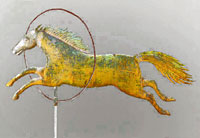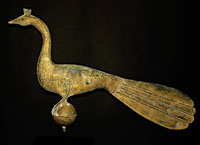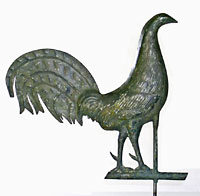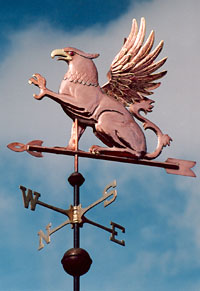Copper Weather Vanes: Then and Now
 One of the most coveted 19th Century weathervanes is A.L. Jewell's unique horse-through-a-hoop. Circa, 1860 to 1865.
One of the most coveted 19th Century weathervanes is A.L. Jewell's unique horse-through-a-hoop. Circa, 1860 to 1865.Courtesy of Halsey Munson Americana
Just as a wind’s direction is known to change, so has the role of the copper weather vane shifted in its storied, centuries-old legacy. Today, the weather vane stands as a glorious symbol of American folk art that emerged from a crude, handcrafted cocoon of weather-indicating function. Rooted in the Old English word fane, which means “flag,” weather vane was an adoption of weather fane.
“But flags were known to wear out rather fast,” jokes Halsey Munson of Illinois-based Halsey Munson Americana, which works with private and public antique and folk art collectors worldwide. “Flags were used to indicate identity and loyalty to a vasal. And in Agrarian societies, knowing what the weather was going to be like was of critical importance—They were utilitarian objects.”
Medieval archers relied on fabric fanes to show them the direction of the wind. But in a turn of this windward tale toward what most resembles the modern weather vane, fabric was soon replaced by metal or wood – vanes decorated with a nobleman or lord’s coat of arm and balanced to turn in the wind.
“Artists were probably hired for those vanes seen on castle walls and of those homes of the wealthy,” says Munson. “They were made of wood or iron at first. … I’ve had several wooden ones, but they are hard to find.”
 With a hollow copper body and molded sheet copper tail, this may have been one of the earliest peacock weathervanes produced by Alvin L. Jewell in his Waltham, MA works. Circa 1852 to 1855.
With a hollow copper body and molded sheet copper tail, this may have been one of the earliest peacock weathervanes produced by Alvin L. Jewell in his Waltham, MA works. Circa 1852 to 1855. Courtesy of Halsey Munson Americana
The earliest weather vane, however wasn’t displayed on an American rooftop, but in ancient Athens atop the Tower of Winds. Greeks felt a weathervane replica of The Sea God of Triton would point out wind direction and weather patterns. Other early examples included bronze Viking vanes shaped into characters from Norse fables adorning ships and Scandinavian churches in the ninth century.
Soon after, legends say that the Pope decreed that every church in Europe should showcase a weather cock on its steeple to signify the Biblical prophecy that the cock would not crow the morning after the Last Supper until Peter denounced Jesus three times.
Copper finally made its industrious, illustrious appearance on American weather vanes in the late 17th century, thanks to artists like Shem Drowne, who created the famous grasshopper weather vane on top of Faneuil Hall in Boston and a copper Indian for Boston’s Province House.
“Weather vanes, in general, were a one-man vision kind of thing,” says Munson. “They weren’t mass-produced.”
 Full body gamecock weathervane with hollow copper body, cast zinc legs and embossed sheet copper tail, showing the work's paint history. Circa 19th Century, Ex-Kauffman Collection.
Full body gamecock weathervane with hollow copper body, cast zinc legs and embossed sheet copper tail, showing the work's paint history. Circa 19th Century, Ex-Kauffman Collection.Courtesy of Halsey Munson Americana
The first signs of mass-production, however, were introduced in the nineteenth century by commercial weather vane manufacturers, such as J. Howard, J.W. Fiske, and A.L. Jewell & Co. Munson finds the handiwork of all three artists to be unique and distinguished in their own “vane.”
“[Jonathan] Howard’s probably date back to 1850 and were the most beautiful ones ever made,” he says, “he usually used cast zinc to weight the front of the weather vane to catch the wind… J.W. Fiske was the only maker that made vanes out of 100 percent copper. He would send out catalogs advertising this and would sneer at those who used zinc. … A.L. Jewell would usually make a horse leaping through an iron hoop, something unique in their endearing, whimsical quirkiness. He was a most imaginative maker.”
Early colonists displayed their patriotism through vanes of the Goddess of Liberty and the eagle. Later in the 19th century, Americans expressed interest in copper weathervane expressions of their surroundings: natives of the New England coast desired fish, seagulls and ships. Western pioneers and farmers would craft their own weathervanes out of wood or sheet iron to resemble pigs, horses, cows and other farm animals, as well as Indians and arrows.
 Griffin Weathervane, by LizAnne Jensen of West Coast Weather Vanes.
Griffin Weathervane, by LizAnne Jensen of West Coast Weather Vanes. Contributed by Ashley Morris
And on the heels of the late 19th century, with the dawn of the Victorian age, came more intricate, elaborate copper weather vanes.
“There was a big demand for weathervanes because there was more affluence,” says Munson. “But the popularity of weather vanes spawned a tremendous growth in weathervane makers. Commercially made vanes identified the wealthy executives and factory owners… These were far more sophisticated and are now the most in demand in the folk art world.”
The demand for vanes waned, however, during the onset of the Great Depression. But a weather vane revolution of sorts later made history in the 1970s, according to weathervane maker LizAnne Jensen, owner of West Coast Weather Vanes.
“In the 1970s, people started catching on to folk art and realized they could take weather vanes to auctions and sell them for $20,000,” she explains. “All of a sudden, people started realizing that they had worthy things on their roofs. And a whole new round of makers emerged and a kind of revival began in the 1980s.”
Styles of weathervanes vary as much as the rich history of these works of folk art. Jim Masterson, the shop foreman at the Metal Museum in Memphis, Tenn., leads a Copper Weather vane class April 24 through May 3.
“Students make things from fish to dragonflies to roosters – it just depends,” he says.
The class uses the open die forming process, with a 32-by-16-inch plywood frame that later acts as a vice. Students cut the profile of their subject out of the die and the copper is placed between the Masonite layers and hammered into a three dimensional shape. The two sides are then soldered together and decorative elements, if desired, are added. “The trickiest thing I remind students is that you have to carefully reverse the image for each side so they match up,” says Masterson. “Anybody can do this, though!”
Weather Vanes of Today
Jensen and her husband, Ken, are two such weather vane makers who were bitten by the revival 20 years ago during their honeymoon in New England.
Worth of Copper Weather Vanes
- In 1999, Cushing & White weather vane sold for $222,500.
- In 2001, an early 20th century locomotive sold for $237,000.
- In 2002, a squirrel (complete with bullet holes) sold for $292,000.
- In 2006, 46-inch Indian with bow and arrow sold for $716,000.
- In 2006, a locomotive sold for $1.2 million.
- In October 2006, the record selling price was set at $5.8 million by Jerry Lauren, executive vice president for men’s design at Polo Ralph Lauren, his brother’s business, for a 5-foot-tall American Indian chief.
- In 2007, Jerry Lauren purchased a man driving an antique touring car (formerly displayed atop a gas station) for $941,000.
“I was a director of marketing at the time and my husband was a reference librarian, but both of us loved to garden,” says Jensen. “We wanted to get a weather vane for our home, but could never find one in California, and all we saw at first were roosters and cows, but nothing relevant to our lives. Driving along the coast of Maine we found a little shop and a man who made Viking ship vanes, which was perfect because my husband had a Danish background. When we told the man that we had such a hard time finding a vane, he said, “That’s because there’s no one in that half of the country making them!”
After the Jensens returned to their home in Santa Cruz, they thought about starting their own shop, saved money for a year and a half LizAnne then quit her high-paying job, and with a line of 600 designs later, West Coast Weather Vanes remains one of the only weathervane makers on the West Coast.
Today, their growing team of makers boasts backgrounds from making stained glass to bicycles.
“My husband had built our house, but the only metal experience he had was soldering the plumbing,” says LizAnne. “The things we can do now have changed since starting.” The Jensens are still devoted to employing the most difficult, time-consuming free form and repousse weather vane making techniques – minus the use of molds – which could take them from three days to two months, depending on the project.
“Copper is the best material because it’s non-ferrous, malleable and hand-shapeable. Copper has longevity and tradition,” says LizAnne. “And the beautiful patina from the weather makes every one unique. Here, by the ocean, the patina will be speckled. In the Northwest, the patina will be streaked…You don’t want to polish off patina.”
Due to copper’s longevity, many of LizAnne clients want to buy weather vanes as gifts to pass down to the next generation. Although LizAnne emphasizes that each weather vane is really personal per client, they can also be costly. Their most expensive weather vane sold was a Mercedes Benz 300 SL for $30,000. The details from front to fender are phenomenal. “We also have a guy coming over tomorrow interested in us making a 1912 Stanley Steamer, which also could be very detailed,” she says.
Also in this Issue:
- Copper Weather Vanes: Then and Now
- Copper Moon Woodworks: Shedding New Light on Windowshutters
- Making Cents: The First Designs and Future of the Copper Cent
- Andy Brinkley: Fusing Nature into Metal
- Cantor Expands Rodin Galleries
